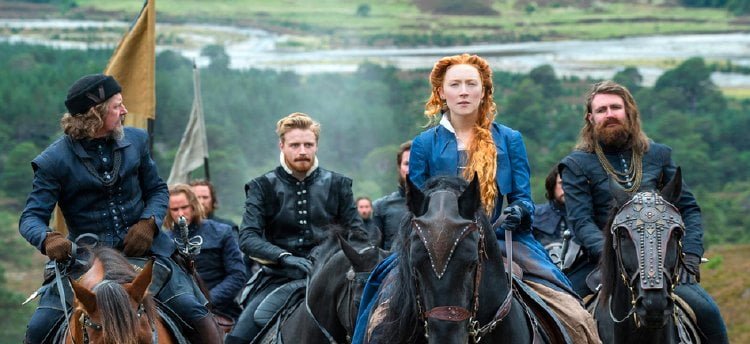Mary Queen of Scots

Mary Stuart (Saoirse Ronan) was Queen of France at 16 and a widow at 18. She returned to her native Scotland to seek her rightful throne, directly challenging her cousin, Elizabeth (Margot Robbie), the Queen of England, to be “Mary Queen of Scots.”
Laura's Review: C
Widowed as the French Queen Consort in 1561 at the age of eighteen, Mary Stuart (Saoirse Ronan) resisted remarriage, instead traveling back to Scotland to assume her rightful throne and challenge the rule of her cousin Elizabeth I (Margot Robbie). The women were intrigued by each other, Mary Catholic and wishing to bear an heir to the throne, Elizabeth Protestant and resigned to ruling as a man. Stuart was willing to recognize her cousin if her own child was guaranteed succession, but forces both external and internal worked against her, leading to a cruel fate for "Mary Queen of Scots." Theater director Josie Rourke makes her feature debut with a lush historical epic which falters in its bid for contemporary relevance. The book from which Beau Willimon adapts his screenplay, John Guy's 'Queen of Scots: The True Life of Mary Stuart,' is admired for meticulous research which shed new light on his subject, but the filmmakers take things several steps further, twisting historical fact into incredible movie moments. Who knew Stuart's second husband, Lord Darnley (Jack Lowden), was really a gay man with a flair for cunnilingus? (He was actually a womanizer, described in Mary's own words as 'lusty.') There are so many strange choices made in this film. While casting diversity is an admirable goal, it is historical fact that Elizabeth's emissary Lord Randolph (Adrian Lester) was not a black man nor Bess of Hardwick (Gemma Chan) Asian. Yes, the Scots of old have been depicted painting their faces blue, but did Mary's brother James Stewart, Earl of Moray (James McArdle), really line his eyes with kohl and sport a disconnected undercut? There is no recorded meeting between the two women, yet while it is reasonable that this might be speculated, Rourke's staging of the two flirting amidst hanging sheer panels as if playing peek-a-boo robs the scene of serious intent. It's a shame, really, because Ronan is, as always, fascinating to watch and Robbie finds some interesting notes to play as well. The film's best element is Jenny Shircore's hair and makeup design, her transformative work on Robbie before, during and after a bout of smallpox extraordinary. The film charts the back and forth between the two women as men try to undermine them. In Elizabeth's court, advisor Sir William Cecil (Guy Pearce) works against Mary, but she has plenty of trouble of her own up north, Protestant John Knox (David Tennant in a rare poor showing) working feverishly to turn her people against her. Mary is portrayed as remarkably progressive, open to religious freedom and even her own ill-fated secretary Rizzio (Ismael Cruz Cordova) cavorting with her maids in drag (another dubious interpretation of fact). She's also quite canny, rebuffing Elizabeth's proffered suitor, the Queen's own 'favorite' Robert Dudley (Joe Alwyn). Mary's second marriage was not a good one, but it did result in an heir and it was her son James who ascended to the throne upon Elizabeth's death (the Stuarts have reigned in Britain ever since). The film both begins and ends with Mary's fabled execution, and Rourke is successful in charting the treachery which made it inevitable despite Elizabeth's actual wishes, but she should have either been bolder with her modern twists or dispensed with them entirely. Grade:
Robin's Review: C+
I love history and movies about history and “Mary Queen of Scots” actually does deal with the facts about Mary and her rebellion against Queen Elizabeth I over the right to the throne. But director Josie Rourke and scripter Beau Willimon take, shall I say, literary license with the details of history – to the point of distraction. This comes, I think, from the filmmakers attempt to modernize that history with racial diversity and sexual preference, neither of which have anything concrete to do with the film’s real focus – palace intrigue. Saoirse Ronan and Margot Robbie both do regal justice to their queenly characters. Each envelopes her role and character and, with costume and makeup, become their personae. But, I cannot say that anyone else in the large cast stands out. The production design, on the other hand, does, including makeup, particularly for Elizabeth, and costume. In my head, I keep comparing “Mary Queen of Scots” to another regal historical film (also at theaters now), “The Favourite.” The latter film hews closely with historical fact and characters and does not try to change the vision of history. The former film looks and acts like a historical drama, but does not feel true to the real story – except for the finale, and even that does not do history justice, either.

